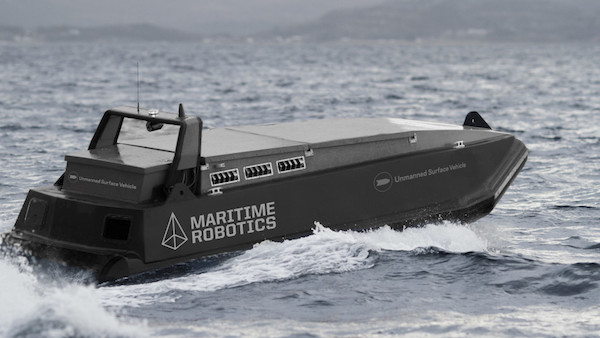Autonomous technology is spreading across numerous applications at an unprecedented pace. Amongst others, the DARPA Grand Challenge for autonomous ground vehicles has given an indication of what is possible to achieve using state-of-the-art sensors in combination with cleverly designed autonomous algorithms. We believe the increasing use of autonomy in vehicle systems eventually will propagate to the maritime industry and that we will see an increasing level of autonomy on ships in order to increase safety, and to reduce operational costs, emissions and impacts from human-induced errors.
The Maritime Robotics Telemetron is a 26 foot dual-use manned-unmanned surface vessel capable of speed up to 36 knots. The vessel hence operates in both displacement, semi-displacement and planing, which calls for special requirements for modeling, identification and control of the vessel. There exists a powerful framework for modeling, identification and control of such vessels, based on a non first-principle model, which has previously been applied to the Telemetron. The framework has been automated through a master thesis during 2017/2018. This combined project and master thesis will focus on further development of the framework, where improving the automated framework and combining it with kinematic control algorithms such as path and trajectory control is the main focus.
As mentioned, this proposal is intended as a combined project and master thesis.
 |
 |
|
|---|---|---|
| USV Mariner, an unmanned surface vehicle | MR Telemetron, a dual-use surface vessel |
 |
|---|
| High-speed velcoity control using MR Telemetron |
Proposed Tasks
For the project assignment, the following tasks are proposed:
- Get familiar with the mentioned framework for modeling, identification and control.
- Investigate possible ideas for further development of the framework. For instance:
- Developing recursive identification of model parameters.
- Including a model of the vessel side-slip.
- Do a literature survey on kinematic control for ASVs, focusing on methods for path- and trajectory- tracking.
- Get familiar with some kinematic control schemes from the literature survey through simulations.
- Investigate a couple of kinematic control schemes, building on already developed vessel speed controllers.
Note that the problem formulation is quite broad and will be tailored to the candidate’s interests.
The formulation of the master thesis will depend on the results from the project assignment, and will be defined at the end of the autumn. Depending on the results, full-scale tests in the Trondheimsfjord can be part of the master thesis.
Autosea
The candidate will be associated with the AUTOSEA project, which is a collaborative research project between NTNU, DNV GL, Kongsberg Maritime and Maritime Robotics, focused on achieving world-leading competence and knowledge in the design and verification of methods and systems for sensor fusion and COLAV for ASVs. The project has access to supervision and physical test platforms through our industry partners. The candidate will most likely be working in collaboration with another student, also working with further development of the framework.
Supervisors
Main supervisor: Morten Breivik.
Co-supervisor: Bjørn-Olav H. Eriksen